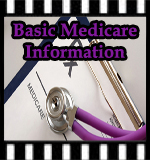J
JoAnne Sheehan
Guest
Last week I asked an office manager for a patient’s Medicare ID number because there was no copy of the card in her medical record. The claim denied for invalid HIC (Health Insurance Claim) number. Her response was, take the patient’s social security number off the registration and add an “A” to it. I listened to her response incredulously and decided to take matters into my own hands. I called the patient.
Another time I received a denial for no Part B coverage. The office manager stated that the patient “did” have Part B coverage because her ID was 555-55-5555B. I realized at that moment that this was no coincidence. My staff deals with this lack of knowledge every day. That is when I decided to give a quick lesson in basic Medicare information. As more and more people have joined the Medicare generation, front desk and billers need to understand how the system works.
Basic Medicare Information – Medical Coding
First, there are four types of Medicare: A, B, C, and D, which cover various services. Most people receive Medicare benefits from the Federal Government:
Part A is hospital insurance coverage only and you will only see Part A listed on the patient’s Medicare card. This covers hospital, hospice, home health care and skilled nursing facilities. “Facility” is the key word here. This does not apply to a physician who provides his “physician services” in a hospital location.
Part B coverage is medical coverage. On the insurance card, you will see Part A AND Part B listed as the type of coverage the patient has. Part B coverage is paid with a monthly premium and covers physician services, durable medical equipment, preventive care and inpatient and outpatient services, lab tests, X-Rays, mental health care and some home health and ambulance services.
Part C is a health care option offered by private payers that provide Medicare benefits in the form of an HMO or PPO. Plan C is called “Medicare Advantage Plan”. Patients must be wise when choosing this form of Medicare coverage. It replaces the original Medicare and acts like an HMO-PPO. They must be certain that the physician and hospital they choose accept the Part C coverage. Hospitals contract with certain HMO-PPO plans and do not accept all Part C plans.

Part D is an outpatient prescription drug insurance and is provided by private insurance companies that have contracts with the government. Part D is never paid for by the government, like Medicare claims are. It is an option for patients due to their needs. If a patient is covered by the original Medicare program, they must choose a stand-alone Part D plan.
I have provided a list of suffixes Medicare attaches to the patient’s SSN. As you can see, an ID number ending in “A” does not mean Part A only and if the ID number ends in “B”, it does not mean Part B coverage only.
SUFFIX DESCRIPTIONS:
A Retired worker over the age 65 or disabled worked
B Wife over the age 65 of a retired or disabled worked (uses spouses SSN)
B1 Husband of retired or disabled worker
B2 Wife whose entitlement is dependent on the care of a child
B3 Second wife
B4 Second husband
B5 Second wife whose entitlement is dependent on the care of a child
B6 Ex-wife whose entitlement is dependent on the care of a child
B7 Third wife whose entitlement is dependent on the care of a child
B8 Third wife
B9 Third husband
C Child category, which includes a disabled child or a student, defined by
age after the letter C.
C1 Youngest child
C2 Next youngest child
C3, 4 Sequenced in order
D Widow
D1 Widower
D2 Second widow
D3 Second widower
D4 Widow who remarried after age 60
D5 Widower who remarried after age 62
D6 Surviving ex-wife
D7 Second surviving ex-wife
E Widowed mother
E1 Mother (ex-wife) who survives the retired worker
E2 Second widowed mother
E3 Second mother (ex-wife) who survives the retired worker
F Parent category for aged dependents; always followed by a number
F1 Father
F2 Mother
F3 Stepfather
F4 Stepmother
F5 Adoptive father
F6 Adoptive mother
F7 Second “alleged” father
F8 Second “alleged” mother
J & K Special beneficiaries whose entitlement depends on the quarters of
employment that they have under social security
J1, J2, K1, K2 Entitled to Part A
J3, J4, K3, K4 Not entitled to Part A, may purchase Part A
M A individual enrolled in Part B who is not entitled to retirement and
survivor’s or Railroad Retirement Insurance and is not eligible for Part A but may purchase Part A coverage
M1 An individual enrolled in Part B who meets the requirements for Part A
coverage
T An individual entitled to Part A benefits but not to retirement and
survivor’s Railroad Retirement Insurance or who is entitled to Medicare
based on chronic renal disease. It applies whether or not the beneficiary
elects to receive Part B
W Disabled widow
W1 Disabled Widower
W2 Second disabled widow
W3 Second disabled widower
W6 Disabled surviving ex-wife
W7 Second disabled surviving ex-wife
As you can see, there is a whole lot more to Medicare than one or two suffixes and in the thirty-three years in the industry, I have pretty much used them all!
Read More about Basic Medicare Information – Medical Coding
Medicare Terminology and Forms To Know
AAPC – Coding with Modifiers: CPT, Medicare, and the Real World

The post Basic Medicare Information – Medical Coding appeared first on [CCO] Medical Coding.
Read More https://www.cco.us/basic-medicare-information-medical-coding/
Continue reading...
Another time I received a denial for no Part B coverage. The office manager stated that the patient “did” have Part B coverage because her ID was 555-55-5555B. I realized at that moment that this was no coincidence. My staff deals with this lack of knowledge every day. That is when I decided to give a quick lesson in basic Medicare information. As more and more people have joined the Medicare generation, front desk and billers need to understand how the system works.
Basic Medicare Information – Medical Coding
First, there are four types of Medicare: A, B, C, and D, which cover various services. Most people receive Medicare benefits from the Federal Government:
Part A is hospital insurance coverage only and you will only see Part A listed on the patient’s Medicare card. This covers hospital, hospice, home health care and skilled nursing facilities. “Facility” is the key word here. This does not apply to a physician who provides his “physician services” in a hospital location.
Part B coverage is medical coverage. On the insurance card, you will see Part A AND Part B listed as the type of coverage the patient has. Part B coverage is paid with a monthly premium and covers physician services, durable medical equipment, preventive care and inpatient and outpatient services, lab tests, X-Rays, mental health care and some home health and ambulance services.
Part C is a health care option offered by private payers that provide Medicare benefits in the form of an HMO or PPO. Plan C is called “Medicare Advantage Plan”. Patients must be wise when choosing this form of Medicare coverage. It replaces the original Medicare and acts like an HMO-PPO. They must be certain that the physician and hospital they choose accept the Part C coverage. Hospitals contract with certain HMO-PPO plans and do not accept all Part C plans.

Part D is an outpatient prescription drug insurance and is provided by private insurance companies that have contracts with the government. Part D is never paid for by the government, like Medicare claims are. It is an option for patients due to their needs. If a patient is covered by the original Medicare program, they must choose a stand-alone Part D plan.
I have provided a list of suffixes Medicare attaches to the patient’s SSN. As you can see, an ID number ending in “A” does not mean Part A only and if the ID number ends in “B”, it does not mean Part B coverage only.
SUFFIX DESCRIPTIONS:
A Retired worker over the age 65 or disabled worked
B Wife over the age 65 of a retired or disabled worked (uses spouses SSN)
B1 Husband of retired or disabled worker
B2 Wife whose entitlement is dependent on the care of a child
B3 Second wife
B4 Second husband
B5 Second wife whose entitlement is dependent on the care of a child
B6 Ex-wife whose entitlement is dependent on the care of a child
B7 Third wife whose entitlement is dependent on the care of a child
B8 Third wife
B9 Third husband
C Child category, which includes a disabled child or a student, defined by
age after the letter C.
C1 Youngest child
C2 Next youngest child
C3, 4 Sequenced in order
D Widow
D1 Widower
D2 Second widow
D3 Second widower
D4 Widow who remarried after age 60
D5 Widower who remarried after age 62
D6 Surviving ex-wife
D7 Second surviving ex-wife
E Widowed mother
E1 Mother (ex-wife) who survives the retired worker
E2 Second widowed mother
E3 Second mother (ex-wife) who survives the retired worker
F Parent category for aged dependents; always followed by a number
F1 Father
F2 Mother
F3 Stepfather
F4 Stepmother
F5 Adoptive father
F6 Adoptive mother
F7 Second “alleged” father
F8 Second “alleged” mother
J & K Special beneficiaries whose entitlement depends on the quarters of
employment that they have under social security
J1, J2, K1, K2 Entitled to Part A
J3, J4, K3, K4 Not entitled to Part A, may purchase Part A
M A individual enrolled in Part B who is not entitled to retirement and
survivor’s or Railroad Retirement Insurance and is not eligible for Part A but may purchase Part A coverage
M1 An individual enrolled in Part B who meets the requirements for Part A
coverage
T An individual entitled to Part A benefits but not to retirement and
survivor’s Railroad Retirement Insurance or who is entitled to Medicare
based on chronic renal disease. It applies whether or not the beneficiary
elects to receive Part B
W Disabled widow
W1 Disabled Widower
W2 Second disabled widow
W3 Second disabled widower
W6 Disabled surviving ex-wife
W7 Second disabled surviving ex-wife
As you can see, there is a whole lot more to Medicare than one or two suffixes and in the thirty-three years in the industry, I have pretty much used them all!
Read More about Basic Medicare Information – Medical Coding
Medicare Terminology and Forms To Know
AAPC – Coding with Modifiers: CPT, Medicare, and the Real World

The post Basic Medicare Information – Medical Coding appeared first on [CCO] Medical Coding.
Read More https://www.cco.us/basic-medicare-information-medical-coding/
Continue reading...
